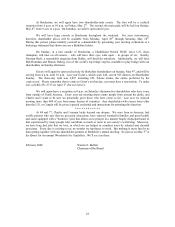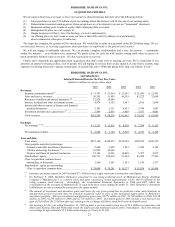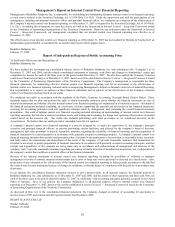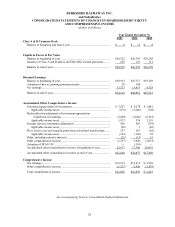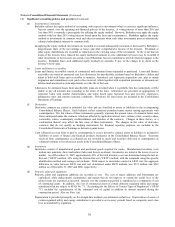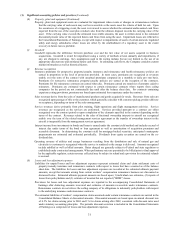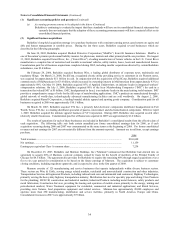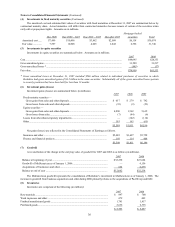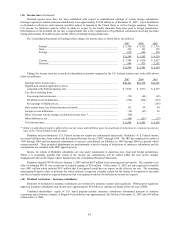Berkshire Hathaway 2007 Annual Report Download - page 33
Download and view the complete annual report
Please find page 33 of the 2007 Berkshire Hathaway annual report below. You can navigate through the pages in the report by either clicking on the pages listed below, or by using the keyword search tool below to find specific information within the annual report.32
Notes to Consolidated Financial Statements (Continued)
(1) Significant accounting policies and practices (Continued)
(l) Deferred charges reinsurance assumed
The excess of estimated liabilities for claims and claim costs over the consideration received with respect to retroactive
property and casualty reinsurance contracts that provide for indemnification of insurance risk is established as a
deferred charge at inception of such contracts. The deferred charges are subsequently amortized using the interest
method over the expected claim settlement periods. Changes to the expected timing and estimated amount of loss
payments produce changes in the periodic amortization charge. Such changes in estimates are determined
retrospectively and are included in insurance losses and loss adjustment expense in the period of the change. The
periodic amortization charges are reflected in the accompanying Consolidated Statements of Earnings as losses and
loss adjustment expenses.
(m) Insurance premium acquisition costs
Costs that vary with and are related to the issuance of insurance policies are deferred, subject to ultimate recoverability,
and are charged to underwriting expenses as the related premiums are earned. Acquisition costs consist of
commissions, premium taxes, advertising and other underwriting costs. The recoverability of premium acquisition
costs generally reflects anticipation of investment income. The unamortized balances of deferred premium
acquisition costs are included in other assets and were $1,519 million and $1,432 million at December 31, 2007 and
2006, respectively.
(n) Regulated utilities and energy businesses
Certain domestic energy subsidiaries prepare their financial statements in accordance with SFAS 71, reflecting
economic effects deriving from the ability to recover certain costs from customers and the requirement to return
revenues to customers in the future through the regulated rate-setting process. Accordingly, certain costs are
deferred as regulatory assets and obligations are accrued as regulatory liabilities which will be amortized over
various future periods. At December 31, 2007, the Consolidated Balance Sheet includes $1,503 million in
regulatory assets and $1,629 million in regulatory liabilities. At December 31, 2006, the Consolidated Balance
Sheet includes $1,827 million in regulatory assets and $1,839 million in regulatory liabilities. Regulatory assets
and liabilities are components of other assets and other liabilities of utilities and energy businesses.
Management continually assesses whether the regulatory assets are probable of future recovery by considering factors
such as applicable regulatory changes, recent rate orders received by other regulated entities and the status of any
pending or potential deregulation legislation. If future recovery of costs ceases to be probable, the amount no
longer probable of recovery is charged to earnings.
(p) Foreign currency
The accounts of foreign-based subsidiaries are measured in most instances using the local currency as the functional
currency. Revenues and expenses of these businesses are generally translated into U.S. dollars at the average
exchange rate for the period. Assets and liabilities are translated at the exchange rate as of the end of the reporting
period. Gains or losses from translating the financial statements of foreign-based operations are included in
shareholders’ equity as a component of accumulated other comprehensive income. Unrealized gains or losses
associated with available-for-sale securities are included as a component of other comprehensive income. Gains
and losses arising from other transactions denominated in a foreign currency are included in the Consolidated
Statements of Earnings.
(q) Income taxes
Berkshire and eligible subsidiaries currently file a consolidated Federal income tax return in the United States. In
addition, Berkshire and subsidiaries also file income tax returns in state, local and foreign jurisdictions as
applicable. Provisions for current income tax liabilities are calculated and accrued on income and expense amounts
expected to be included in the income tax returns for the current year.
Deferred income taxes are calculated under the liability method. Deferred income tax assets and liabilities are based on
differences between the financial statement and tax bases of assets and liabilities at the current enacted tax rates.
Changes in deferred income tax assets and liabilities that are associated with components of other comprehensive
income (primarily unrealized investment gains and losses) are charged or credited directly to other comprehensive
income. Otherwise, changes in deferred income tax assets and liabilities are included as a component of income tax
expense. Changes in deferred income tax assets and liabilities attributable to changes in enacted tax rates are
charged or credited to income tax expense in the period of enactment. Valuation allowances have been established
for certain deferred tax assets where realization is not likely.
Assets and liabilities are established for uncertain tax positions taken or positions expected to be taken in income tax
returns when such positions are judged to not meet the “more-likely-than-not” threshold based on the technical
merits of the positions. Estimated interest and penalties related to uncertain tax positions are included as a
component of income tax expense.
(r) Accounting pronouncements adopted in 2007 and 2006
Berkshire adopted FASB Interpretation No.48 “Accounting for Uncertainty in Income Taxes-an interpretation of FASB
Statement No. 109” (“FIN 48”) as of January 1, 2007. Under FIN 48, a tax position taken is recognized if it is
determined that the position will “more-likely-than-not” be sustained upon examination by a taxing authority. FIN
48 also establishes measurement guidance with respect to positions that have met the recognition threshold. See
Note 13 for additional information.


